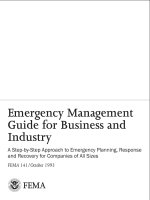Study guide for sell and sell short
Bạn đang xem bản rút gọn của tài liệu. Xem và tải ngay bản đầy đủ của tài liệu tại đây (1.94 MB, 145 trang )
FM_SSS_SG-p2.qxd
3/31/08
11:40 AM
Page iii
STUDY GUIDE
FOR
SELL AND SELL SHORT
Dr. Alexander Elder
www.elder.com
John Wiley & Sons, Inc.
FM_SSS_SG-p2.qxd
3/31/08
11:40 AM
Page vi
FM_SSS_SG-p2.qxd
3/31/08
11:40 AM
Page i
STUDY GUIDE
FOR
SELL AND SELL SHORT
FM_SSS_SG-p2.qxd
3/31/08
11:40 AM
BOOKS
Page ii
BY
DR. ALEXANDER ELDER
Trading for a Living
Study Guide for Trading for a Living
Rubles to Dollars:
Making Money on Russia’s Exploding Financial Frontier
Come into My Trading Room
Study Guide for Come into My Trading Room
Straying from the F lock: Travels in New Zealand
Entries & Exits: Visits to Sixteen Trading Rooms
Study Guide for Entries & Exits
FM_SSS_SG-p2.qxd
3/31/08
11:40 AM
Page iii
STUDY GUIDE
FOR
SELL AND SELL SHORT
Dr. Alexander Elder
www.elder.com
John Wiley & Sons, Inc.
FM_SSS_SG-p2.qxd
3/31/08
11:40 AM
Page iv
Copyright © 2008 by Dr. Alexander Elder. All rights reserved.
Published by John Wiley & Sons, Inc., Hoboken, New Jersey.
Published simultaneously in Canada.
All charts unless otherwise noted were created with TradeStation.
Copyright © TradeStation Securities, Inc. 2000–2007. All rights reserved.
No part of this publication may be reproduced, stored in a retrieval system, or
transmitted in any form or by any means, electronic, mechanical, photocopying,
recording, scanning, or otherwise, except as permitted under Section 107 or 108 of
the 1976 United States Copyright Act, without either the prior written permission of
the Publisher, or authorization through payment of the appropriate per-copy fee
to the Copyright Clearance Center, Inc., 222 Rosewood Drive, Danvers, MA 01923,
(978) 750-8400, fax (978) 750-4470, or on the web at www.copyright.com.
Requests to the Publisher for permission should be addressed to the Permissions
Department, John Wiley & Sons, Inc., 111 River Street, Hoboken, NJ 07030, (201)
748-6011, fax (201) 748-6008, or online at />Limit of Liability/Disclaimer of Warranty: While the publisher and author have
used their best efforts in preparing this book, they make no representations or
warranties with respect to the accuracy or completeness of the contents of this
book and specifically disclaim any implied warranties of merchantability or fitness for a particular purpose. No warranty may be created or extended by sales
representatives or written sales materials. The advice and strategies contained
herein may not be suitable for your situation. You should consult with a professional where appropriate. Neither the publisher nor author shall be liable for
any loss of profit or any other commercial damages, including but not limited to
special, incidental, consequential, or other damages.
For general information on our other products and services or for technical support, please contact our Customer Care Department within the United States at
(800) 762-2974, outside the United States at (317) 572-3993 or fax (317) 572-4002.
Wiley also publishes its books in a variety of electronic formats. Some content
that appears in print may not be available in electronic books. For more information about Wiley products, visit our web site at www.wiley.com.
ISBN 978-0-470-20047-6
Printed in the United States of America
10
9
8
7
6
5
4
3
2
1
FM_SSS_SG-p2.qxd
3/31/08
11:40 AM
Page v
CONTENTS
About This Study Guide
vii
Section One: Questions
1 How to Buy, Manage Risk, & Keep Records
Questions 1–36
3
2 How to Sell
Questions 37–86
21
3 How to Sell Short
Questions 87–115
45
Section Two: Answers and Rating Scales
1 How to Buy, Manage Risk, & Keep Records
Answers 1–36
Grading your Answers
61
2 How to Sell
Answers 37–86
Grading your Answers
83
3 How to Sell Short
Answers 87–115
Grading your Answers
113
What’s Next?
131
About the Author
133
v
FM_SSS_SG-p2.qxd
3/31/08
11:40 AM
Page vi
FM_SSS_SG-p2.qxd
3/31/08
11:40 AM
Page vii
ABOUT THIS STUDY GUIDE
I
t feels exciting to discover an attractive stock and watch it go vertical after you buy. It is just as exciting to see it collapse soon after
you short. This joy is only a small part of the game.
You can expect to spend the bulk of your time doing your homework. At times you might scan a long list of stocks and not find anything particularly attractive. At other times you may find a stock that
you like but your money management rules will not allow you to buy.
Or you can put on a trade in moments but spend half an hour documenting it in your diary. The toil of homework takes up the bulk of a
serious trader’s time. Whoever said “success is 10% inspiration and 90%
perspiration” must have come through Wall Street.
I created this Study Guide to help you prepare for the road ahead.
My goal was to point out some of the best opportunities, flag some of
the worst risks, and get you into the habit of tracking your performance. I often say to my students, “Show me a trader with good records,
and I will show you a good trader.” I hope this Study Guide will help
you acquire the habit of asking hard questions, testing all ideas on your
own data, and keeping good notes.
This book is divided into three sections. The first focuses on buying,
managing money, and keeping records; the second on selling; and the
third on selling short. Each section, in turn, consists of two parts. In
the beginning, there are textual questions, and towards the end there
are visual questions, with charts that require you to make trading
decisions. Each section concludes with a scale to help you gauge your
performance.
vii
FM_SSS_SG-p2.qxd
viii
3/31/08
11:40 AM
Page viii
About This Study Guide
I took great care in crafting the answers in the back of the book.
I wanted to go beyond merely saying that A was right and B was
wrong—I wanted to explain the reasons behind the answers. Because
of these extensive comments, the Answers section of this Study Guide
serves as an extension of the main book, Sell and Sell Short.
Please do not rush through this book. Trading is a marathon, not a
100-yard dash. Take your time to think and work through a few questions each day. After you have worked through the entire Study Guide
and rated your performance, put it aside for two or three months, then
pick it up again and retake the tests to see whether your grades have
improved. Trading is like so many other serious pursuits—the more you
put into it, the more you will get out of it.
Trading is a lonely business, which is why I encourage traders to
connect with others and share research and learning. Some of my students have become good friends, and here I want to acknowledge the
contribution of Jeff Parker, a camper and a member of the Spike group.
He reviewed and critiqued both Sell and Sell Short and this Study
Guide. Jeff is a very kind guy, but an extremely hard man to please.
He made dozens of critical comments which helped me improve this
book. This manuscript would have been finished sooner and with less
pain if I had not shown it to Jeff, but the book came out better thanks
to him. Now, by picking up this Study Guide and facing its hard questions you have made the same choice as I did. When we expose ourselves to the risk of criticism, we become stronger.
I cordially wish you success in your trading career.
Dr. Alexander Elder
New York City, 2008
c01_SSS_SG-Q-p3a.qxd
4/1/08
3:34 PM
Page 1
S E C T I O N
O N E
QUESTIONS
c01_SSS_SG-Q-p3a.qxd
4/1/08
3:34 PM
Page 2
c01_SSS_SG-Q-p3a.qxd
4/1/08
3:34 PM
Page 3
O N E
HOW TO BUY,
MANAGE RISK,
& KEEP RECORDS
W
hen I sat down to write a book about selling, it soon became
clear that it had to begin with a section on buying and all
that relates to it. Beginners buy when some vague tips float their way.
Experienced traders know that serious buying requires serious
research.
Scanning the stock market and researching individual stocks is very
important, but analysis alone will not make you a successful trader.
Serious buying requires good money management. There are simple
mathematical rules that tell you how much risk you may accept on any
individual trade as well as on all your open trades combined. Those
who violate risk limits have a very short life expectancy in the markets.
There are certain psychological rules that can help you make your
life in the markets less stressful and more satisfying and profitable. And
there are certain highly desirable ways of record-keeping that will help
you grow into a mature and successful trader.
You have to buy well in order to sell well.
That is why, before we discuss selling and shorting, you need to
answer important questions about psychology and money management, buying decisions, and record-keeping.
Please do not rush as you work through this chapter. A house is only
as strong as its foundation. Please answer these questions with a great
deal of thought and record them on the Answer Sheet on pages 4 and
5. Re-read the appropriate sections in Sell and Sell Short if you miss any
answers.
3
c01_SSS_SG-Q-p3a.qxd
4/1/08
3:34 PM
Page 4
Questions
4
Answer Sheet
Questions
Max. Pts.
Available
1
1
2
1
3
1
4
1
5
1
6
1
7
1
8
1
9
1
10
1
11
1
12
1
13
1
14
1
15
1
16
1
17
1
18
1
19
1
20
1
21
1
22
1
23
1
24
1
25
1
26
1
Trial 1
Trial 2
Trial 3
Trial 4
Trial 5
Trial 6
(continuing)
c01_SSS_SG-Q-p3a.qxd
4/1/08
3:34 PM
Page 5
How to Buy, Manage Risk, & Keep Records
5
Answer Sheet, continued
Questions
Max. Pts.
Available
27
1
28
1
29
1
30
1
31
1
32
1
33
1
34
1
35
1
36
1
Total points
36
Trial 1
Trial 2
Trial 3
Trial 4
Trial 5
Trial 6
c01_SSS_SG-Q-p3a.qxd
4/1/08
3:34 PM
Page 6
Questions
6
Question 1—The Stress of Holding a Position
Having bought a stock, most people find themselves in the least stressful position if that stock:
1.
2.
3.
4.
Rises slightly
Skyrockets
Declines slightly
Collapses
Question 2—Your Trading Edge
Your trading edge can come from:
1.
2.
3.
4.
Fundamental analysis
Technical studies
Discipline
All of the above
Question 3—The Three Great Divides
The three great divides in trading include all of the following, except:
1.
2.
3.
4.
Technical vs. fundamental research
Trend vs. counter-trend trading
Relying on TV news vs. an advisory service
Discretionary vs. systematic trading
Question 4—Price and Value
Find the incorrect statement about the relationship between price and
value:
1. Values change slowly, prices change fast.
2. Studying earnings reports and industry trends allows you to discover
value.
3. Moving averages help define the value zone by tracking public
consensus.
4. Price equals value at any given moment.
c01_SSS_SG-Q-p3a.qxd
4/1/08
3:34 PM
Page 7
How to Buy, Manage Risk, & Keep Records
7
Question 5—Fundamental and Technical Analysis
Which of the following statements about fundamental and technical
analysis is incorrect?
1. A fundamentalist calculates the value of the business that issued a
stock.
2. Having precise information about the fundamentals tells you exactly
which way a stock is going to go.
3. A technician looks for repetitive patterns in price data.
4. A pure technician does not care about earnings or corporate news;
he only wants to know the stock ticker and price history.
Question 6—Trend vs. Counter-Trend Trading
All of the following are advantages of trend trading over counter-trend
trading, except:
1.
2.
3.
4.
Greater profit potential per trade
Lower commission expense
More time to make decisions
Lower stress level
Question 7—System vs. Discretionary Trading
System trading has all of the following advantages over discretionary
trading, except:
1. Knowing in advance what profits or losses to expect over a period
of time
2. Less emotional involvement in every trade
3. A greater degree of freedom
4. A method for handling the uncertainty of the markets
c01_SSS_SG-Q-p3a.qxd
4/1/08
3:34 PM
Page 8
Questions
8
Question 8—Technical Toolbox
A technical trader uses a toolbox of indicators in his or her decisionmaking. Find the correct statement among the following:
1.
2.
3.
4.
Selecting the tools that give the signals you want is a sound practice.
The more tools, the better the toolbox.
“Five bullets to a clip” allows you to use only five indicators.
The best indicators are well known, and a trader should use them.
Question 9—New High–New Low Index
Find the incorrect statement about the New High–New Low Index:
1. NH-NL confirms uptrends by reaching new highs; it confirms downtrends by falling to new lows.
2. The signals of NH-NL are symmetrical at tops and bottoms.
3. Bearish divergences of NH-NL warn of impending market tops.
4. Downspikes of NH-NL often identify important market bottoms.
Question 10—Trading Psychology
Find the incorrect statement about trading psychology:
1. If you set your technical system just right, you need not worry about
psychology.
2. The mind of a trader continually filters the incoming information.
3. Wishful thinking causes traders to “see” non-existent technical signals.
4. A bullish trader is more likely to overlook sell signals.
Question 11—Trading Discipline
Traders need discipline because the markets present an endless parade
of temptations. Please identify the incorrect statement among the
following:
1. People with a history of poor impulse control are likely to fail in
trading.
2. AA (Alcoholics Anonymous) provides a useful model for dealing
with market temptations.
3. If you have a good trading system, discipline is not really an issue.
4. Some traders have personality flaws that make them destined to fail.
c01_SSS_SG-Q-p3a.qxd
4/1/08
3:34 PM
Page 9
How to Buy, Manage Risk, & Keep Records
9
Question 12—Dealing with Losses
Many traders feel ashamed of their losses. Please review the following
statements and find the correct one:
1. In training, punishments are more effective than rewards.
2. If you have taken several right steps and one wrong one in making
a trade, you should punish yourself for it.
3. Successful traders love the game more than the profits.
4. It does not pay to keep records of losing trades.
Question 13—Overtrading
Trading a position that is too large for one’s account will lead to all of
the following, except:
1.
2.
3.
4.
Less spontaneity and greater stiffness
Less calm and adaptability
Fear of pulling the trigger
A greater focus on the market
Question 14—The 2% Rule
A beginning trader with a $20,000 account decides to implement the
2% Rule of money management. He finds a stock quoted at $12.50 and
decides to buy it, with a price target of $15 and a stop-loss order at
$11.50. The maximum number of shares this Rule allows him to buy is
close to:
1.
2.
3.
4.
900
400
350
200
c01_SSS_SG-Q-p3a.qxd
4/1/08
3:34 PM
Page 10
Questions
10
Question 15—Modifying the 2% Rule
An experienced trader with a $2,000,000 account decides to modify the
2% Rule and cap his risk per trade at 0.25%. He finds a $9 stock which
he plans to ride to $12, while putting his stop at $8. The maximum
number of shares his Rule allows him to buy is:
1.
2.
3.
4.
2,000
4,500
5,000
12,000
Question 16—The 6% Rule
Find the statement about the 6% Rule that is correct:
1. It will protect your account from a drawdown caused by a bad trade.
2. It will protect your account from a drawdown caused by a series of
bad trades.
3. When losses begin to mount, the best response is to trade more
actively, to trade your way out of a hole.
4. The 6% Rule needs to be applied after putting on a trade.
Question 17—The Top Two Goals for Every Trade
What are the top two goals for every trade?
1.
2.
3.
4.
Make money and test a new system.
Face the challenge and feel the joy of victory.
Make money and become a better trader.
Test your discipline and the ability to implement a plan.
Question 18—Learning from Experience
The best way to learn from experience is:
1.
2.
3.
4.
To
To
To
To
make lots of trades
keep good records
discuss your trades with friends
review your brokerage statements
c01_SSS_SG-Q-p3a.qxd
4/1/08
3:34 PM
Page 11
How to Buy, Manage Risk, & Keep Records
11
Question 19—A Record-Keeping Spreadsheet
Which of the following must be included in a basic record-keeping
spreadsheet?
A.
B.
C.
D.
1.
2.
3.
4.
Gross and net P&L
The grade of each trade
Slippage on entry and exit
Source of every trade idea
A
A and B
A, B, and C
All of the above
Question 20—Trading Mistakes
Which of the following statements about trading mistakes is incorrect?
1.
2.
3.
4.
Intelligent people do not make mistakes.
Making mistakes is inevitable when you learn and explore.
Repeating mistakes is a sign of impulsivity.
Keeping a diary helps you learn from your mistakes.
Question 21—Trader’s Diary
Find the correct statement about the Trader’s Diary:
1. There is no need to rush documenting your entry if you plan to fill
in the diary after you exit.
2. The diaries of losing trades tend to be more valuable than those of
winning ones.
3. It is essential to create diary entries only for your best trades.
4. An active trader who cannot document all trades can pick and
choose what trades to document.
c01_SSS_SG-Q-p3a.qxd
4/1/08
3:34 PM
Page 12
Questions
12
Question 22—Diary Entry
The diary of an entry into a trade must include all of the following,
except:
1.
2.
3.
4.
The reason for making this trade
The buy grade for long or sell grade for short trades
Charts of your trading vehicle at the time of the entry
The trade grade
Question 23—Trading Plan vs. Diary
Which of the following describes the difference between a Trader’s
Diary and a Trading Plan?
1.
2.
3.
4.
Contains charts in two timeframes.
The charts are marked up to identify buy or sell signals.
The document is named after the stock ticker.
Buy or sell grades are recorded.
Question 24—The Monitoring Screen
The window for monitoring stocks in your trading software should
include all of the following, except:
1.
2.
3.
4.
Key market indexes
Your open positions
The stocks you consider trading
The stocks you have exited
Question 25—Comments on the Screen
Keeping your comments about your open positions on the screen is
useful for all of the following reasons, except:
1. It reminds you how long you have been in a trade.
2. It helps you see whether you are winning or losing in an open
position.
3. It helps you keep track of your profit target and stop-loss order.
4. It helps you measure your performance.
c01_SSS_SG-Q-p3a.qxd
4/1/08
3:34 PM
Page 13
How to Buy, Manage Risk, & Keep Records
13
Question 26—Pinning a Chart to a Wall
“Margret’s method”—pinning a chart to a wall and marking the trading
signal for which you will be waiting—has all of the following advantages, except:
1. It forces you to clearly express what price or indicator action you
expect.
2. It keeps you from forgetting a plan.
3. Removing the charts from the wall if your plans change helps keep
your mind fresh.
4. Keeping charts on a wall ensures that you will act when the time is
right.
Question 27—A Trial-Sized Order
Which of the following statements about a “Chihuahua trade”—a trialsized order designed to draw your attention to a trading opportunity—
is correct?
1. There is little difference between an electronic alert and an order
for a handful of shares.
2. Chihuahua orders are good for placing stops.
3. Getting a fill on a Chihuahua order forces you to make a decision.
4. Once you have a fill on a trial-sized order, you must bring that trade
up to full size.
Question 28—Grading Buys and Sells
Find the incorrect statement about grading buys or sells:
1.
2.
3.
4.
The closer you buy to the low of the bar, the better your grade.
The closer you sell to the low of the bar, the better your grade.
Selling above the midpoint of the bar earns a positive grade.
Buying in the lowest quarter of the bar earns an excellent grade.
c01_SSS_SG-Q-p3a.qxd
4/1/08
3:34 PM
Page 14
Questions
14
Question 29—Grading Completed Trades
Find the correct statement about grading completed trades:
1. Money is a good measure of the quality of each trade.
2. A long-term trend trader can use channels to measure the quality of
trades.
3. A trade capturing over 30% of a channel earns an “A.”
4. A trade capturing less than 20% of a channel earns a “D.”
Question 30—Buying
Find the incorrect statement about buying:
1. The principle of value buying is “buy low, sell high.”
2. The principle of momentum buying is “buy high, sell even higher.”
3. The upper channel line identifies the level of depression and the
lower channel line the level of mania in the markets.
4. Momentum trading works well in runaway trends.
Question 31—Value
B
B
B
C
A
A
Figure 1.31
A









